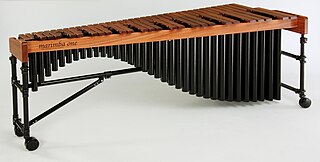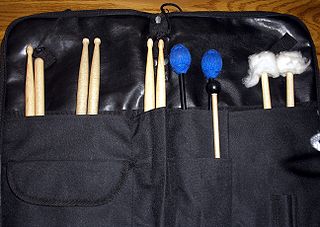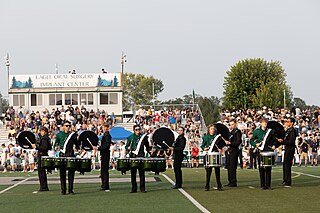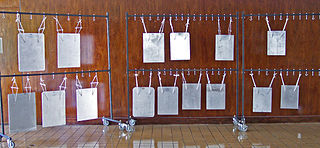
A percussion instrument is a musical instrument that is sounded by being struck or scraped by a beater including attached or enclosed beaters or rattles struck, scraped or rubbed by hand or struck against another similar instrument. Excluding zoomusicological instruments and the human voice, the percussion family is believed to include the oldest musical instruments. In spite of being a very common term to designate instruments, and to relate them to their players, the percussionists, percussion is not a systematic classificatory category of instruments, as described by the scientific field of organology. It is shown below that percussion instruments may belong to the organological classes of idiophone, membranophone, aerophone and chordophone.

The xylophone is a musical instrument in the percussion family that consists of wooden bars struck by mallets. Like the glockenspiel, the xylophone essentially consists of a set of tuned wooden keys arranged in the fashion of the keyboard of a piano. Each bar is an idiophone tuned to a pitch of a musical scale, whether pentatonic or heptatonic in the case of many African and Asian instruments, diatonic in many western children's instruments, or chromatic for orchestral use.

The marimba is a musical instrument in the percussion family that consists of wooden bars that are struck by mallets. Below each bar is a resonator pipe that amplifies particular harmonics of its sound. Compared to the xylophone, the marimba has a lower range. Typically, the bars of a marimba are arranged chromatically, like the keys of a piano. The marimba is a type of idiophone.

The vibraphone is a percussion instrument in the metallophone family. It consists of tuned metal bars and is typically played by using mallets to strike the bars. A person who plays the vibraphone is called a vibraphonist,vibraharpist, or vibist.

The glockenspiel or bells is a percussion instrument consisting of pitched aluminum or steel bars arranged in a keyboard layout. This makes the glockenspiel a type of metallophone, similar to the vibraphone.

The celesta or celeste, also called a bell-piano, is a struck idiophone operated by a keyboard. It looks similar to an upright piano, albeit with smaller keys and a much smaller cabinet, or a large wooden music box (three-octave). The keys connect to hammers that strike a graduated set of metal plates or bars suspended over wooden resonators. Four- or five-octave models usually have a damper pedal that sustains or damps the sound. The three-octave instruments do not have a pedal because of their small "table-top" design. One of the best-known works that uses the celesta is Pyotr Ilyich Tchaikovsky's "Dance of the Sugar Plum Fairy" from The Nutcracker.
Chimes are a percussion instrument struck with hammers.

A metallophone is any musical instrument in which the sound-producing body is a piece of metal, such as tuned metal bars, tubes, rods, bowls, or plates. Most frequently the metal body is struck to produce sound, usually with a mallet, but may also be activated by friction, keyboard action, or other means.

A percussion mallet or beater is an object used to strike or beat a percussion instrument in order to produce its sound.

Marching percussion instruments are percussion instruments specially designed to be played while moving. This is achieved by attaching the drum(s) to a special harness worn by the drummer, although not all marching bands use such harnesses and instead use traditional baldrics to sling their drums.

A mark tree is a percussion instrument used primarily for musical colour. It consists of many small chimes—typically cylinders of solid aluminium or hollow brass tubing 3/8" in diameter—of varying lengths, hung from a bar. They are played by sweeping a finger or stick through the length of the hanging chimes. They are mounted in pitch order to produce rising or falling glissandos.
The glass marimba is a type of idiophone also known as a vitrephone or crystallophone. Marimba translates to "a xylophone-like instrument" from an African language, probably Bantu. The glass keys are made of either hard glass or soft glass. The keys are resonated with either a single open top box or individual resonators for each key. Mallets used to play the marimba can be constructed using a compressed silicone ball attached to one end of a wooden or synthetic dowel. These mallets bring out the purest sound from glass marimba. Other types of mallets are used for different effects. The tuning system of a glass marimba can be whatever is desired. Glass marimbas are utilised by the Brazilian percussion ensemble, Uakti.

A gendèr is a type of metallophone used in Balinese and Javanese gamelan music. It consists of 10 to 14 tuned metal bars suspended over a tuned resonator of bamboo or metal, which are tapped with a mallet made of wooden disks (Bali) or a padded wooden disk (Java). Each key is a note of a different pitch, often extending a little more than two octaves. There are five notes per octave, so in the seven-note pélog scale, some pitches are left out according to the pathet. Most gamelans include three gendèr, one for sléndro, one for pelog pathet nem and lima, and one for pelog pathet barang.
Struck idiophones is one of the categories of idiophones that are found in the Hornbostel-Sachs system of musical instrument classification.

A bell tree, also known as tree bells or Chinese bell tree, is a percussion instrument, consisting of vertically nested inverted metal bowls. The bowls, placed on a vertical rod, are arranged roughly in order of pitch. The number of bowls can vary between approximately 14 and 28. An effective glissando is produced by sliding a triangle beater, a glockenspiel mallet, or a xylophone mallet down the length of the tree. The bells are usually pitched to microtonal intervals and do not represent any formal scale. When a glissando is played, the inexactness of the order of the bowls' pitch is unnoticeable, merely creating a fuller sound.

A bell plate is a percussion instrument consisting of a flat and fairly thick sheet of metal, producing a sound similar to a bell. They are most often used in orchestral and theater music.

A keyboard percussion instrument, also known as a bar or mallet percussion instrument, is a pitched percussion instrument arranged in the same pattern as a piano keyboard and played with hands or percussion mallets. While most keyboard percussion instruments are fully chromatic, keyboard instruments for children, such as ones used in the Orff Schulwerk, may be diatonic or pentatonic.
This is a partitioned list of percussion instruments showing their usage as tuned or untuned. See pitched percussion instrument for discussion of the differences between tuned and untuned percussion. The term pitched percussion is now preferred to the traditional term tuned percussion:

J. C. Deagan, Inc. is a former musical instrument manufacturing company that developed and produced instruments from the late 19th- to mid-20th century. It was founded in 1880 by John Calhoun Deagan and initially manufactured glockenspiels. It was noted for its development of the xylophone, vibraharp, organ chimes, aluminum chimes, aluminum harp, Swiss handbells, the marimba, orchestra bells, and marimbaphone.

















